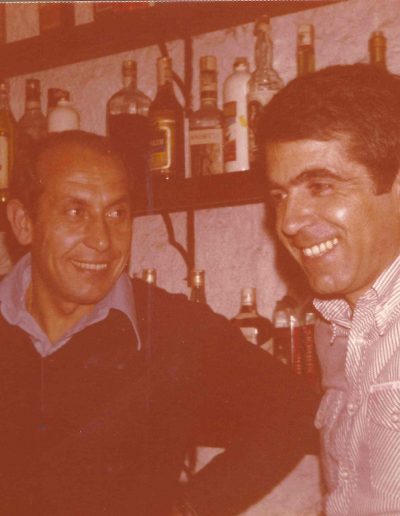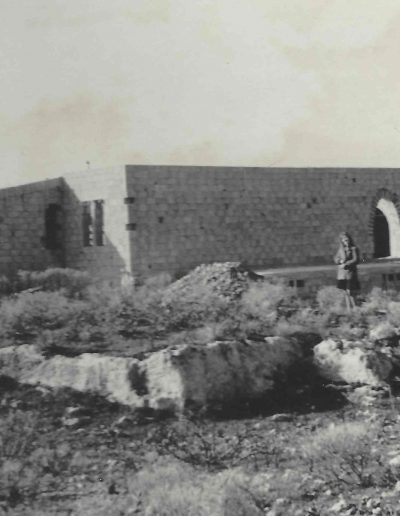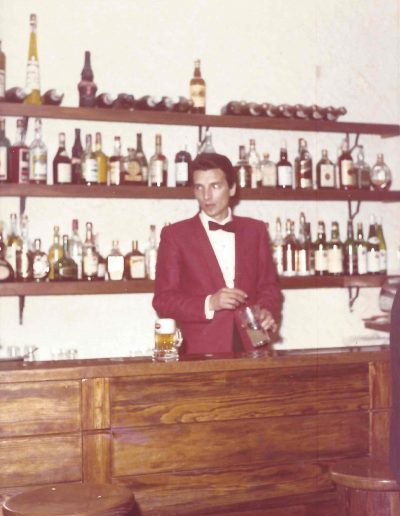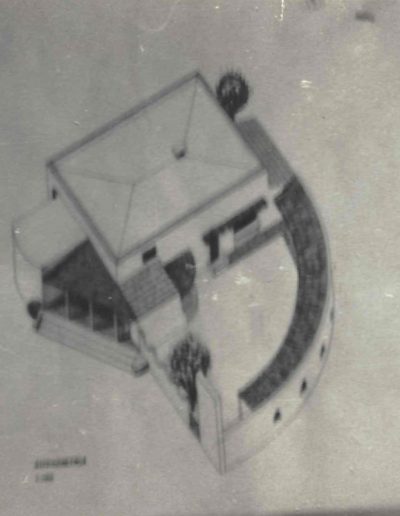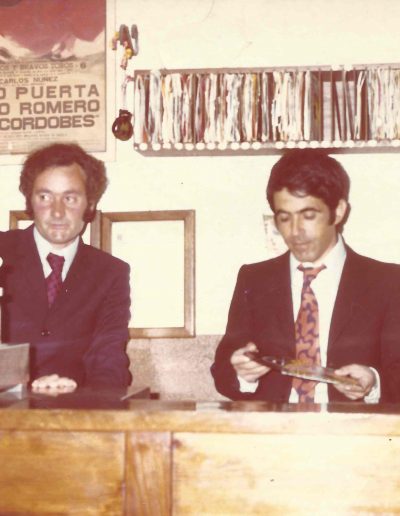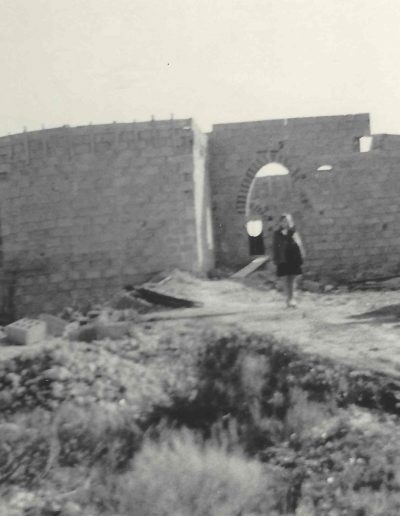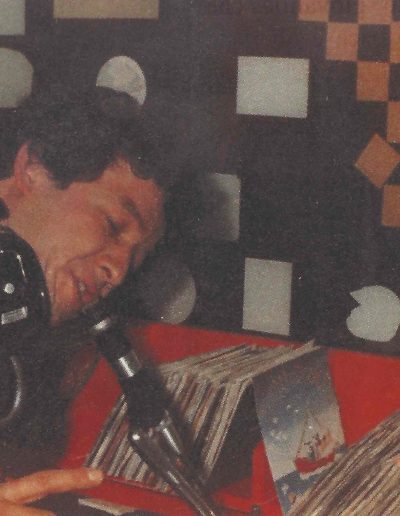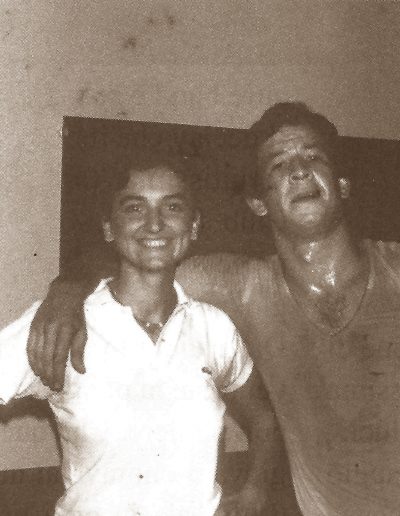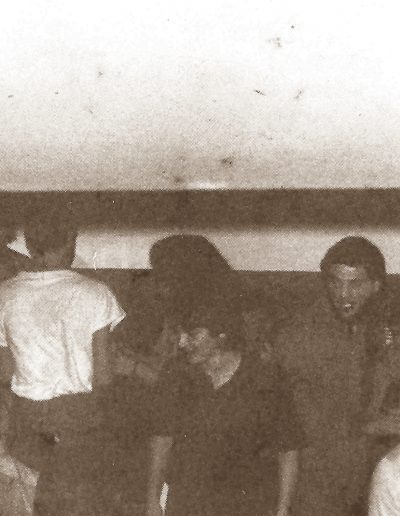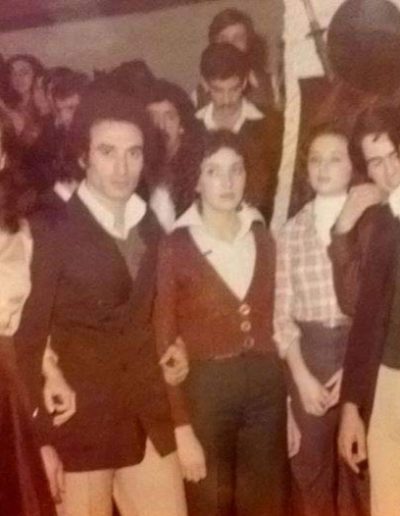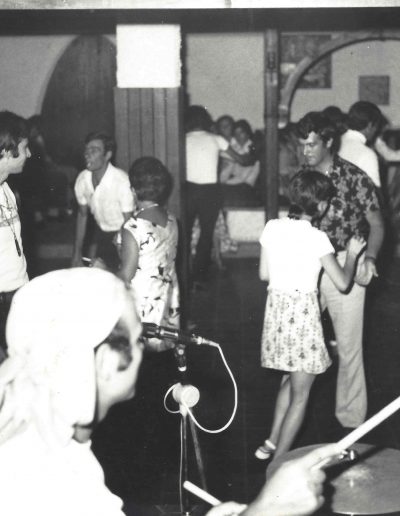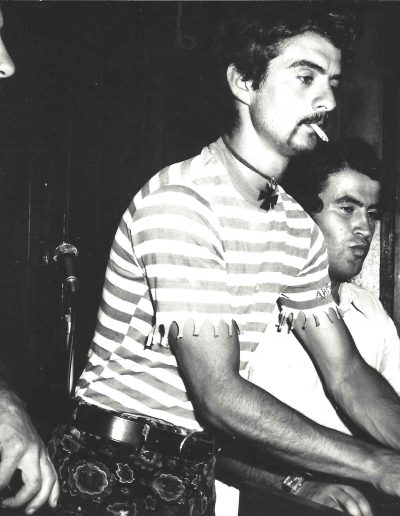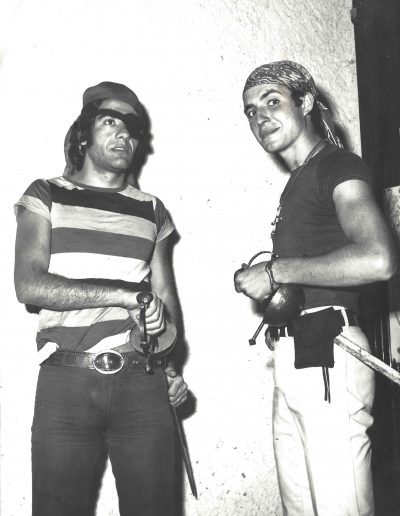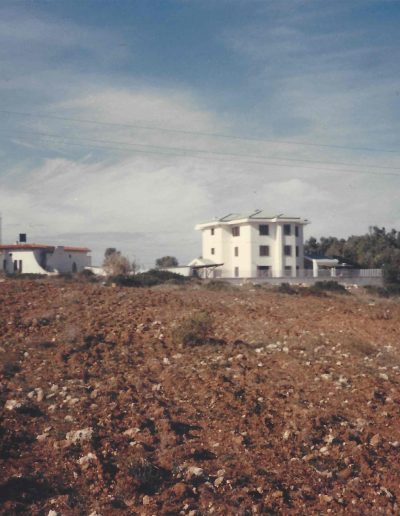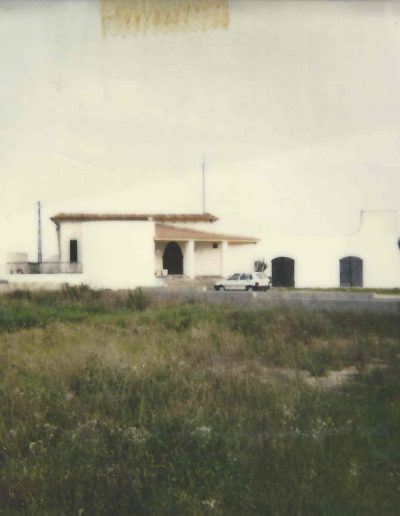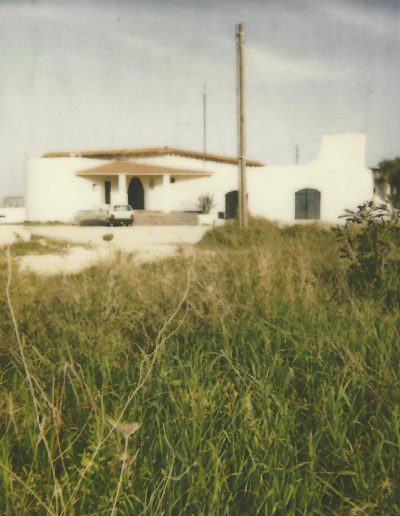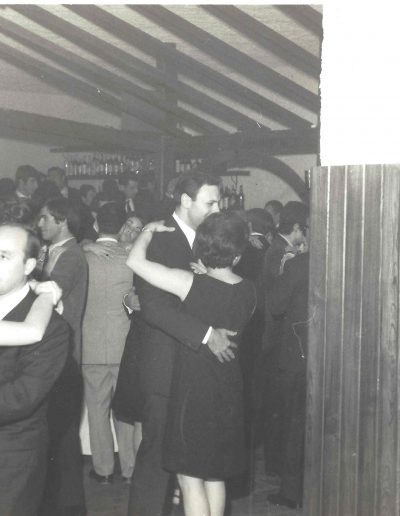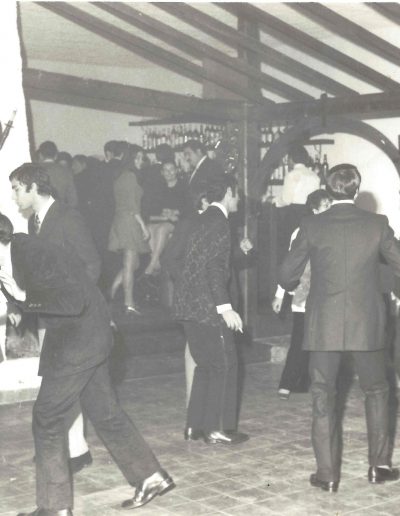1960s/’70s: the birth of Serra li Pozzi in the memory of Giovanni Congiatu…
by Emanuele Fancellu
Entrepreneurs, dances and famous bullfighters. There is all this and more behind El Cordobes, one of the most famous dance clubs in Porto Torres. That dance hall was born at the dawn of Sir’s economic miracle. The burgeoning petrochemical industry, bringing in thousands of workers and technicians from the mainland and the rest of the island, quickly transformed a town of emigrants into an Eldorado where they could stop to work and start a family. And where inevitably to seek moments of leisure and fun. At the time Porto Torres ended at the height of the old cemetery, the area of the future district of Serra li Pozzi was far from the built-up area. But the history of El Cordobes is inextricably linked to that of Serra li Pozzi. And it is from here that Giovanni Congiatu, architect of that epic undertaking together with brothers Salvatore and Battista Scarpa, begins his account.
“ The area where today’s neighborhood of Serra li Pozzi stands was owned by two families – Giovanni begins -. Piga, Salvatore Bazzoni’s mother, owned the upper part where today the residence il Melo up to the Carlo Felice is located in two separate mappings, and also the part where the Contessa’s house is, which, however, had its entrance in the alley of the Vigne, so much so that where the shrine of the ward is there is an unbuilt part then entrance to the Piga property. Piga had sold most of that land to Countess Altobelli. In between crept land belonging to the Falcons, a family of four sisters and a brother, Vittorio, who was always bedridden and later died. One of these four sisters married a certain Gianuario Spanedda. There had already been a division of the property, and the part where the newsstand is today belonged to Maria, the sister who married Spanedda. It was a desert” Giovanni Congiatu continues, “the only thing there was a little country house where the Loi family lived, later to become owners of the land still theirs today. Spanedda had a few cows and took them out to graze. One morning a certain Antonico Masia, older brother of the distributor Masia, arrived there. He was an already elderly man, retired. He lived in Genoa and had worked in catering on ocean liners. He had some money, not a lot of it, and since in 1965 the only road to the nascent industrial area was the old Carlo Felice, on which all the trucks passed that then crossed Corso Vittorio Emanuele, Via Ponte Romano, and the bridge itself, he had taken it into his head to build a motel, a hotel-restaurant for truckers, along the road. The two strolled by the area where today’s Hotel Libyssonis stands, and speaking in Sardinian Antonico said: I have half a mind to buy a piece of land”… we’ll give it to you!” Spanedda answered him. They immediately made the price, a verbal agreement, and went together to notary Maniga. I sold him two thousand meters of land, will he do the deed for us?”… You need a surveyor to do the fractionation” replied the notary”. So the two turned to Giovanni Congiatu. “They came to me and I proposed to him the fractionation corresponding to the part not where the Libyssonis’ entrance is, but the one that faces the newsstand” Giovanni explains, “then the two parts were reunited because the other was sold by the other sister”.
In fact, Serra li Pozzi was born with this agreement between Gianuario Spanedda and Masia. “ When I started making these splits the other Falchi sisters sharpened their wits. They were certainly not rich, they had a dairy on Alfieri Street in front of the Piccolo Forno di Corda and these lands, but they weren’t yielding anything. The youngest, Mrs. Antonina, who ran the whole thing, came to me and said she wanted to sell. “We had a notebook and there we marked “X gave 20 thousand liras, Y 30”… I convinced them to leave ten meters to make the roads, otherwise there would be no access to the land ” says Giovanni to continue: “ I bought at a favorable price the land where today stands the Melo then also extended to the current adjacent Scarpa property. At that time there was no allotment because this was an agricultural area and the municipality would not do anything. Serra li Pozzi came into existence illegally because the various mayors let it be and only later was the plan made”.
“ A first draft of the Libyssonis’ plan was done by me however I did not go ahead because then Masia leaned on relatives in Sassari, the Gavinis, home builders who had their own engineer. So they paid me my due and they did the project giving furthermore the name Libyssonis ” Giovanni reveals. “ With the purchase of another portion of land since the first one was insufficient, the project was approved and the hotel purchased after various vicissitudes by the Scarpas was born”.
The neighborhood began to rise. “ They would come to me and others to do the plans, but I only did one for Duilio Ginatempo, which was approved because he had more than 4,000 meters of land. The one where El Cordobes arose was also approved because it had more than 4 thousand meters of land and was not a dwelling, while all the others started illegally and were later sanitized. Thus Serra li Pozzi was born”.
The 1970s: dancing to … El Cordobes!
The birth of Serra li Pozzi, the times of the first Turritan disco remembered by Giovanni Congiatu, Vittorio Bellu, DJ Luciano Di Fraia…
by Emanuele Fancellu
“The idea of opening a facility in which to dance was born by chance. We were in our early thirties – Giovanni premised -, I owned the land, and I was Battista Scarpa’s partner in some of the projects, as well as being his designer. He was a contractor, and among other things had started the Hotel La Casa project, where many relocators were staying. In Via Alessandro Volta I had a plot of land and I sold it to him in exchange for two apartments, plus I gave him half of the land in Serra li Pozzi, so we became co-owners. One day we were on our way to Cagliari because we had business in the region and we said, “but what do we do with that land?” At that time in Porto Torres we only danced at Carnival at the cinema, so I came up with this idea, 50/50 partners me and the Scarpa brothers”.
Birth of El Cordobes. “ The club was born not without problems – Giovanni resumes –. Local politics fraught a thousand difficulties, but I managed to get the building permit. In addition, all the concessions from the Sassari police headquarters were needed, and here again there were several adversities until a prefect broke down the situation. We had good luck, even among adversity: we could not have electricity and only at the end did Enel connect us; we could not have a well, which was also essential. We had it dug with the pile driver; when we got about ten meters away – the water was 50 meters away – the judiciary came from Sassari and blocked us. We already had the space but not the water. How to do it? I agreed with Duilio Ginatempo, he was my client. Done the project, after a couple of months he received threats. Then we had to buy a plot of land, later sold to Stefano Mannoni, relatively close by. Having dug the well we built a pipeline and bought a powerful motor to send water into the reservoir, staying that way until the pipeline passed. A war!”
La Structure. “ The style was similar to that of Mossa, like the white houses in Gallura, then it was called the Mediterranean style. We built it out of concrete blocks” says Giovanni “. It was a fairly luxurious place to begin with. The road to get there was winding, however, inside we had done things right. There was an outdoor dance floor with covered seating, a sliding wall opened up, and the orchestra could see it and hear who was dancing outside and who was inside. Plus those who wanted to be more private could hear the music downstairs as well. So simultaneously there was dancing outside, inside and below. There were three dance floors. It was a small little club, but we got 400 people in there, we would have been arrested today! We were the first to put in panic bars and all these things you had to get from outside because here they didn’t even know what they were! In Milan I had bought for 250 thousand liras an electronic device made by a craftsman that transformed music with lights. A strobe, it didn’t exist here then. I would put it next to the records and the lights would come on according to the bass. I went on a trip, it was a time when Battista was running it, and when I came back the device had broken. Battista, who was an electronics genius, went, whatever, we fixed it, we got it fixed!” The La Casa hotel sign simply turned on and off. He had this thing replaced by adopting the same principle and said, “this is even better!”
The inauguration. “ We fixed the day of the inauguration, they had issued us a license to run the place despite a thousand difficulties, and we had already invited all the authorities of the town – Giovanni resumes -. On the morning of that day they came from the police headquarters and withdrew my license, but we inaugurated anyway despite all the obstacles placed even by those who were previously friends”. It was November 20, 1969, and Giovanni recounts: 300 people came, the best people in Porto Torres. Everything was free for everyone, Gianni Davis, singer of the Baronets, performed”.
Immediate success. “ We even implanted a radio that was superior in power even to Radio del Golfo, it was called Radio del Cordobes. High school kids ran it, but one day I shut it down. I was pissed off because I found them all dancing!”. This is one of the thousands of anecdotes forever enshrined in the walls of El Cordobes recalled by Giovanni, who picks up on the early days: “ success was immediate. Initially, not being very experienced, we set the entrance fee with attached consumption at 800 liras, but it is obvious that a fine whiskey is different from other drinks, so in the process we corrected this and other mistakes. Apart from the land, we had spent 18 million to build the whole thing, for inauguration expenses, furnishings, and facilities. But only four months later, at the end of the carnival, we had already collected – not earned – 13 million! We had a lot of expenses, but it was a huge success. The clientele was large, there were a lot of movers and shakers, and many often came from neighboring countries as well. Then at Carnival there were masquerade balls… It filled up immediately with people because there was nothing in Porto Torres. The other little clubs were born later, in the wake somewhat of this one. The first manager was a certain Paolo Muner, a navy officer from Trieste who went on leave. He has relatives here. He was way ahead of his time, thorough and able to come up with elegant cocktails and drinks. Agostino Di Turco’s brother and Agostino himself had roles. One waiter was Stefano Cozzolino, others from Sassari. A very good bartender who now lives in Tempio was a certain Francolino: we offered him more and took him away to Giovanni Acciaro of the Offelleria. He was the first bartender and because he was tiny we had to place a platform behind the counter!”
Name. “ There was this Spanish style-I had made trips to Spain and had seen a bullfight by Manuel Benitez known El Cordobes as he was from Cordoba. It came to me that way. It’s the name of a famous bullfighter who is still living, he was very brave and it always went well for him, he faced the bull without fear”.
Music & dancing. “ Sometimes I used to put on music too, but one who came in as a kid was Luciano Di Fraia. With Battista we had an agreement: “One year I run it, one year you run it.” The year I ran it I would get help from Vittorio Bellu. We used to put on Italian stuff or stuff from outside, when we went around to Spain I would bring Spanish records that weren’t here, I would have Rome bring me some – says Giovanni -. We were very well equipped, they all disappeared, man! We had started with 45s, there were always two turntables. The first system was made by one who was at the Garibaldi Hemicycle in Sassari, the other Paurotto, he was famous in Sassari. At the tea dances, in the afternoon, or at night, on Saturdays and Sundays we danced ballroom dancing, twists, alligalli, rock & roll with the orchestra or with DJs armed with hundreds of 33 and 45 rpm records. Occasionally someone would be invited. Once we had called a kind of Argentine juggler, his name was Teresito. This one had some pretty heavy balls and we tell him to give it a try. He did it in the basement and slammed them on his head, he almost stayed there! Teresito…Every end of the night was announced by a theme song, an old Spanish song, needless to say titled “Cordobes”.
The end of the golden age. “There was a fire in ’76, we saved the structure but not the wooden parts. To put it back together I think we spent 16 million and the insurance company only gave us six million, so we signed a bunch of promissory notes and rolled up our sleeves: I would come and work with Salvatore Scarpa, we would be behind the counter because people kept coming in on Sundays. We ran it for a while, then out of the blue there was the issue of the famous Sundays walking because of the Gulf crisis, and on Sundays here they had to come by car. We got scared and leased it out” Giovanni explains. Since then, management changes and less fortunate periods. Until one day Laura, the little girl of the Congiata house, returned from Milan, and the facility came back to life, becoming an elegant and hospitable residence. Il Melo!
El Cordobes, the memory of Vittorio Bellu
“ When Giovanni, Baptist and Salvatore opened the establishment they needed a manager. They turned to a Navy officer who was in the harbormaster’s office in Porto Torres, who had just been discharged because he wanted to marry a local girl. His name was Muner. He stayed not even a year, so they proposed the directorship to me. I gladly accepted. In fact I ran El Cordobes for a couple of years, until 1973 more or less. The place was going strong, it was the hardest working place in Sardinia. I found out later, it was deduced from the weekly amounts paid to Siae in Sassari. On Sunday afternoons we were making as many as 500 attendees, they were coming from all over the province. The downward parabola began when the Mampea opened in Alghero: Giovanni and the Scarpas were unable to renew themselves, moreover they had other priority activities, and slowly there was decay when the beautiful youth chose to go to Alghero, although I tried to organize something different. One evening I saw two elegant si-gnors come in. They asked, “do we want to talk to the director,” “that’s me.” They had come especially from Rome to see why a lo-cal with the numbers of ours had had this collapse. I explained it to them. They took note of it. They probably thought we weren’t pulling tickets anymore ”. He speaks in one breath Vittorio Bellu in recalling the parable of El Cordobes. “ The place was very quaint, Mediterranean-style. There were two indoor rooms while the third outdoor one opened only in summer. There was little lighting especially in the basement, where there were privé-like areas albeit open, and there was also a bar and small tables with armchairs and services. There were saloon-like doors that acted as security doors. On the outdoor track there was a kind of pergola that covered both the part where there were tables with armchairs and the track. Even the doors to the bathrooms were like those of saloons – he resumes -. We also had a few weddings, birthdays and parties. You paid 500 liras entrance fee in the afternoon with a free drink, and you could drink what you wanted. On Sunday afternoons a lot of very young people came; in the evening it was a whole different clientele, much more adult. There was a clear differentiation. In the summer it was open every day”.
Vittorio reveals how for Carnival they organized dancing for the children, “ but the spirit was not felt as Porto Torres was used to. Before, we only danced at Carnival at the Giordo cinema and the event was much more heartfelt, when we opened we danced every day. There were absolutely no drugs circulating, every now and then the little orchestra would be invited to propose something different. One group in particular would come in the summer, they were friends of Antonello Accioni and they would come after being at the beach all day, very tired. They lasted a short time” Vittorio says laughing. “Antonello Accioni was my cousin, he was the barman at Cordobes – he explains -. I had hired him. He was frequenting the Costa Smeralda at the time, Mia Martini was with them, totally unknown at the time. They were guys going around and trying to barge their way around the Costa. Also in that group were the Bussu twins, one of whom became a DJ of mine, and such a guy Arrigoni, a great guy. Antonello said they would come, he hoped all four of them would be hired, but we could only get him as a bartender and Bussu as a DJ. They brought something new, they were very well known in the Sassarese environment and a lot of people followed them. Antonello was a particular guy, he used to put scented sticks in the room. Nobody did that at that time, and they perfumed the room. He dressed very extravagantly: he had shoulder-length hair and a very sharp face, he wore a bartender’s jacket with nothing underneath even in winter, some riding pants with boots on them. He was a peculiar but cool guy”.
Speaking of particular parties and organizations, Vittorio reveals how he also hosted a fashion show “ organized by Paola Falchi who had a store on the Corso: it was very successful ”; the “Festa del Pirata” (Pirate’s Feast) – “ another extraordinary success ” -, and “Gli spaghetti a mezzanotte” (Spaghetti at Midnight) about which he tells a spicy anecdote: “ one night all the hookers and pimps from Sassari arrived in Porto Torres, it was a very fun evening and they behaved very well”.
However, there was also a very unpleasant episode… “ Yeah ”, Vittorio recounts. “One night John was not there, and I was about to close the place at two in the morning. Seven thugs arrived from Sorso, one put his foot in the door and prevented me from closing it. They went inside and effectively held me and two waiters hostage for a couple of hours. My girlfriend was also there but I managed to get her to run away. They asked for a drink and at the time of the bill I made a mistake. I should have told them “it’s on the company” to make them go away, but their arrogance prompted me to say “this is the bill.” So they reacted and threw a glass towards me, I dodged it and broke a few bottles. I tried to wriggle out of it, sneakily asked Giammario, a bartender’s helper before Antonello’s arrival, to call the carabinieri, but they smelled it and threatened me heavily. I became very frightened. They were jail leftovers and the same night, after telling me they were coming back to visit, they did the same thing in Platamona at Ernesto’s bar with worse consequences. I read about it in the New Sardinia the next day”. “ Once the decadence started I left because of work requirements. It was a fantastic and for me a period of rebirth. When they proposed me to be the director I was in fact back from two years residing in the hospital for a lung injury. When I was discharged, the chief physician said, “You have to do one or two months in the mountains every year.” In Porto Torres I was unemployed, exhausted from the treatment I had received I had resigned from a company in the industrial area. Like a fool. So I accepted the proposal. In the disco the smoke was slicing through despite the presence of two huge vacuum cleaners. I said, “If I don’t get sick now, I won’t get sick again.” And in fact, here I am” Vittorio Bellu explains with a smile.
Luciano Di Fraia, the debut at El Cordobes
When one thinks of a Turritan radio dj the first name is undoubtedly that of Luciano Di Fraia. Luciano is also a great entertainer of square parties and is, above all, one of the best-known DJs at the legendary El Cordobes. In fact, today we can say without a doubt the most famous. El Cordobes for Luciano represents a dip into the good times of his youth and, in particular, his debut behind the console. “ In the early 1970s I was a student, I must have been 17 or 18, I lived on Balai Street in front of the newsstand. I knew and frequented the masters of the La Casa hotel, the Scarpas, the headquarters where several Sir transferists were staying” Luciano began, to continue: “ at the time there was one of the greatest barmen in the province of Sassari, Antonello Accioni. Antonello’s wife was the DJ at El Cordobes and at that time she became pregnant with their second child. So she had to abdicate and the disco was looking for a new DJ. I proposed, “I’ll come””. Thus began the adventure behind the cymbals. “El Cordobes was the first disco in Porto Torres, and Serra li pozzi did not yet exist. It was far from the city, the streets were muddy in the winter and dusty in the summer – the DJ says -. But there was an economy in Porto Torres, money was flowing and people wanted to have fun. Flocks of young people were coming from Sassari and the hinterland, as well as many workers. I was a student, I wanted to round up. We would leave on a motorcycle from the La Casa hotel together with Antonello Accioni, and when we arrived there were already about 20 cars parked waiting for us. It was always a full house. There were three dance floors, the outdoor one was really going strong in the summer, it had seats on either side and a reed bed to cover it. In summer it opened every day, in winter only on Saturdays and Sundays ”. Luciano, who is on his way to a record fifty years behind the console, reveals a detail about himself before continuing on disco life: “ When I proposed, I was fasting on the world of DJs. Back then, LPs and 45s were used. She initially made me the set list, said, ‘follow me.’ She suggested that I put colors on the records to memorize the playlist and learn the titles. So slowly I learned“.
In Platamona in the summer he danced at the Pontinental hotel, frequented by tourists, especially British, “ but there we danced poolside, had private parties and entered only by invitation. I was a DJ there a few times” Luciano reveals. In Porto Torres before El Cordobes, people danced only at Carnival at Cinema Giordo, where the Danzante and Veglione went. A pattern replicated by El Cordobes as well. “ We would have the Danzante from 6 to 9 p.m., then we would stop for a moment, clean the ashtrays and give a general tidying up, in the meantime I would go for a quick bite to eat at the Libyssonis hotel with Salvatore Scarpa, and from 10 p.m. we would resume with the evening veglione until late at night” says Luciano, who continues: “ the clientele was varied, many came from outside. What attracted them was only and exclusively a desire for healthy fun, there were no fights or drugs, at most a few skirmishes. The busiest times were carnival and summer, when costume theme nights were organized with camping Cristina. the music that was going then was 70s dance, the Village people, they danced ballroom dancing, samba, alligalli, limbo, rock’n’roll, The tunes of the 60s. i was only as a DJ, i was one of the pioneers, and at the time live music was not used. a characteristic of mine, however, was always to propose at a certain point in the evening the slow ones. the slow ones were liked and liked, the floor would fill up. the slow always pulls. several people used to come on vacation to northern Sardinia, and among them I met the great Radio Monte Carlo dj Federico the Flying Dutchman, then not yet very famous, Who used to frequent Camping Cristina and come to dance at El Cordobes. It was an unforgettable experience, the first time is never forgotten”.
he memory of Angelo Acaccia and Eugenio Cossu
Also remembering that legendary disco are two friends of the Courier, Angelo Acaccia and Eugenio Cossu. “ El Cordobes represented for me the most beautiful period of youth and allowed one to experience the Porto Torres of that period in all its splendor and well-being. Everyone worked in the town and those who did not work meant that they did not want to work, families were large and prosperity visible. El Cordobes and all the activities of the period were proof of that. We all had money a little bit, even as students”. Angelo Acaccia’s eyes light up: as he talks about El Cordobes, he actually gives a picture, yet another, of how rich, opulent and effervescent Porto Torres was in the 1970s. “ Initially it was a nightclub, it was called Night Club El Cordobes, but of course it was not the nightclub as we understand it today”Angelo explains to continue: “ it was very nice because in the afternoon from 5 to 8:30 it functioned as a disco for young people, while in the evening it was frequented by adults. People went on weekends. There was a period in the mid-1970s with a series of events and theme nights. I remember a very nice one organized by the tourists at Camping Cristina, which was very well attended. I remember two friends who worked at the bar, Antonello Accioni, a very good barman and exquisite person, and Giuseppe Nieddu, who later emigrated to London where he started a successful business. In particular then I remember that there was a beautiful parade in 1974 where I also paraded”.
“ I was dancing a twist! ” laughingly attacks Eugenio Cossu referring to the photograph in which he dances wildly in the foreground. “ El Cordobes has been the reference point for our generation ever since it opened” says Eugenio to continue: “
first there was Ciaobella and the Six Days of Cinema Giordo, because when Battista Scarpa and Giovanni opened El Cordobes it became our second home. It was a disco where we stayed together with our friends who were allowed to come. It was a nice environment, of young people, very nice and run by very serious people. There was no cockiness allowed, you went dancing in a suit and tie, unbelievable in today’s days. We danced twists, alligallos, rock’n’roll but most of all the slow ones, the most important thing to make mooolta friends with our girlfriends!” jokes Eugenio before the closing remark: “ for the first time we had a club to be proud of even towards Sassari. It was well known, a landmark, what is missing today. Our generation was the luckiest in the eternal history of Porto Torres because there was job security, no city except Cagliari had the same security as we did”.

